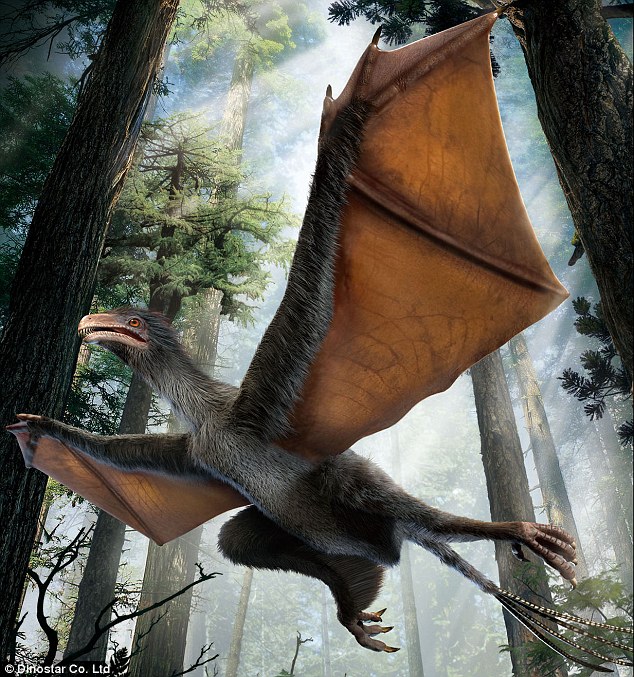A bizarre new dinosaur with bat-like wings has been discovered by a farmer in China and is now helping to shed new light on the evolution of flight.
Palaeontologists in China say the impeccably preserved fossil belongs to a small dinosaur thought to have lived 160 million years ago.
The strange-looking creature had small stiff feathers on its body and long finger-like bones extending from each wrist that were covered in a membrane like a bat’s wing.
Scientists believe the dinosaur, which they have named Yi qi, meaning ‘strange wing’, may have glided or even flown through the air.
Researchers say the dinosaur, which would have weighted just 13 ounces (380g), may have been an early evolutionary experiment with flight.
Yi qi belongs the group of carnivorous dinosaurs known as the therapods - which includes Tyranosaurus rex and velociraptor.
These dinosaurs are thought to have been the ancestors of modern birds.
But unlike modern birds, Yi qi was found to have a strange extra bone extending backwards from its wrist, rather like an entirely separate group of animals that learned to fly - the bats.
Professor Xing Xu, one of the world’s leading prolific palaeontologists at the Chinese Academy of Sciences in Beijing and who led the work, said: 'This is really something for me. It is the most unexpected discovery I ever made.
'Birds are descended from dinosaurs, but how exactly the transition occurred is not really clear. This new discovery is a new species of these bird like dinosaurs.
'This dinosaur is totally different. It has totally different wings from all other birds and their close relatives.
'Close to the origin of birds there are many lineages trying to get into the air but there was only one group that succeeded.
'I would have said this example shows how much experimentation close to this transition.'
The discovery comes in the same week as researchers announced the discovery of a bizarre vegetarian relative of the T-Rex.
The Yi qi fossil was discovered by a local farmer in Mutoudeng, in Qinglong County, Hebei Province in China.
The fossil has preserved stiff filamentous features on the forelimb and hindlimb, along with patches of the membrane that once stretched across its wings.
However, it was the strange wrists and long rod-like bones that extended from them that baffled the attention of the palaeontologists.
There are three main groups of flying vertebrates - the birds, which evolved from dinosaurs, pterosaurs that were flying reptiles that existed alongside the dinosarus, and the bats, which are mammals that evolved after the extinction of the dinosaurs 66 million years ago.
Most winged avian dinosaurs to be discovered so far all have wing structures that are similar to those of modern birds.
However, Yi qi, which is pronounced 'ee chee', appears to be a weird hybrid between a dinosaur and a bat.
This suggests that at the time several different types of winged dinosaurs evolved wings in an attempt to fly.
Analysis by Professor Xu and his colleagues, which is published in the journal Nature, suggest that it is likely the dinosaur glided, perhaps like modern flying squirrels.
The dinosaur lacked the strong muscle attachments to the forelimb bones and its bone structure would have interfered with the flapping and rotating movements needed during powered flight.
Instead it may have launched itself from elevated perches and glided to the ground. If it did flap its wings it would probably have only been able to fly over short distances.
But Professor Xu said: 'We thought giving this animal a name meaning "strange wing" was appropriate, because no other bird or dinosaur has a wing of the same kind
'We don’t know if Yi qi was flapping, or gliding, or both, but it definitely evolved a wing that is unique in the context of the transition from dinosaurs to birds.'
It is likely that the conclusions will be controversial with other evolutionary biologists, but it could prove hugely valuable in unravelling how birds evolved from their dinosaur ancestors.
Professor Zheng Xiaoting, from Linyi University in Shandong who also took part in the study, said: 'Yi qi lived in the Jurassic, so it was a pioneer in the evolution of flight on the line to birds.
'It reminds us that the early history of flight was full of innovations, not all of which survived.'
Dr Kevin Padian, a palaeontologist at the University of California Berkeley, warned that the animal may not have been able to fly at all.
(dailymail.co.uk)



www.ann.az
Follow us !











